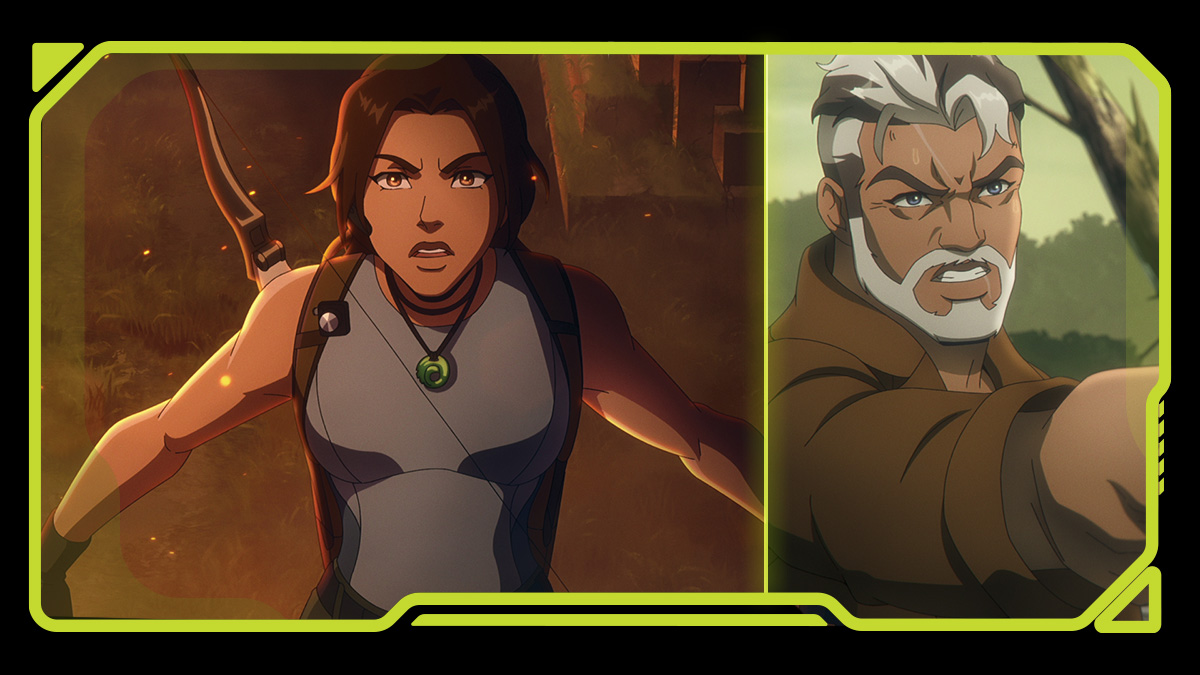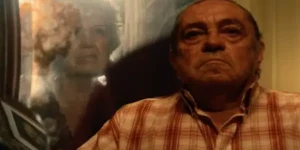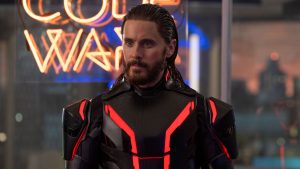
This article is presented by
For nearly 30 years, one of the biggest icons in video games has been Lara Croft, the unflappably cool protagonist of the Tomb Raider franchise. As development on the video game series continues into the current generation, Netflix has adapted Tomb Raider into its star-studded new original animated series, Tomb Raider: The Legend of Lara Croft. Developed by Tasha Huo, the series is set after the events of 2018’s Shadow of the Tomb Raider as Lara (Hayley Atwell) scrambles around the globe to stop the villainous Devereaux (Richard Armitage) from using an ancient relic that could plunge the world into complete chaos.
In an exclusive interview, Tomb Raider: The Legend of Lara Croft showrunner and executive producer Tasha Huo talks about bringing the beloved video game franchise to life on Netflix, explains the creative possibilities of connecting Shadow of the Tomb Raider with the classic games from the ’90s through the show, and teases what fans can expect when The Legend of Lara Croft premieres this week.
Den of Geek: The Legend of Lara Croft takes place after Shadow of the Tomb Raider, which is a very rich creative ground. How was it having that trilogy of games as your narrative foundation?
Tasha Huo: It’s really fun because even though we want to remain very faithful to what Crystal Dynamics is planning and what to look forward to in the games, it is this really cool in-between time where we kind of get to do, in some ways, whatever we want because we’re dealing with the baseline of who she was in Shadow of the Tomb Raider, which was this young woman just surviving and trying to get by. She is full of grief and does something so horrible as to usher in the apocalypse.
We get to move her from that vulnerable place to the fun Lara Croft we remember from the very early games and the movies with Angelina Jolie. It’s this great transitional phase for Lara, which is perfect for a TV show where you get to explore her emotions and inner psyche. We’re this really fun bridge where not only do we have a lot to play with, but we also get to show how she evolves into the person that we remember.
Lara isn’t an island herself; you’ve brought in a supporting cast to help her, including familiar faces from the games.
It’s great because, as a TV show, you can’t just have someone on an island. [Those characters] became really great foils for Lara, people who she can bounce her issues off of. They can be the voice of the audience saying, “Hey, Lara! Snap out of it! Are you really going to do that crazy thing right now? Is that the best way to handle your problems?”
They also allow us to bring in some humor and comedy as a foil against Lara’s even flatness as she evolves into that person who is also funny. She’s so funny in the early games, but we have to build her to that. They allow for the comedy as she’s moving into that person.
More than just being set on a single island or remote mountain temple, The Legend of Lara Croft has a global scope. How was it building the world and its locations around this story?
For me and the writers, it was all about the history driving the locations. Sometimes, you want to take Lara someplace just because you want to be in that place, but really, you need a reason because the audience is going to find out you put them there because you just wanted them to be there. The history was driving us, and the deeper we dove, the more we’d find a thread in this country or that one that could be a cool set piece if we moved Lara there and it worked within the mythology that we’re dealing with. We always want to ground it in something real.
While the show doesn’t pull its punches, it’s also not as graphically violent as the 2013 Tomb Raider reboot game. How did you want to strike a balance with the violence and tone of the series?
We wanted the show to be for everyone. I definitely wrote it with adults in mind as my primary audience, but, absolutely, you can bring your whole family into this and experience Lara Croft. I don’t want to distance anyone, but we are also this bridge into a more fun version of Lara and that guided the tone as well.
The show is animated by Powerhouse Animation Studios, which also did the acclaimed Castlevania series. How was it working with them to create a vision of Tomb Raider that was instantly recognizable, yet with your own signature visual stamp?
They’re fantastic! A big reason it was so exciting to work with them is because most of their team working on this show are women, specifically women who really loved Tomb Raider. They’re women who were moved by it growing up as little girls, and it was so cool to see their excitement being translated into the artwork. I never had to explain Lara’s physicality or her unique penchant for randomly flipping to get to places. These were all things that they inherently knew, and, as fans, they were plugging in really fun things in some of the action and animation that was in the script. You’d get it back and be like, “Hell yeah! You clearly played Tomb Raider: Legend and knew that one moment.”
We could all nerd out about this and what it should be. We were always aiming to have a show that fans would absolutely geek out over, which is what we were doing, but also be accessible to everyone else. It’s a fine balance, but it’s super cool how big fans they were.
What are your own earliest memories of Lara Croft and Tomb Raider?
My earliest memories are being terrified and having nightmares of T-rexes, velociraptors, and sharks. I feel like some of my fear of dark water definitely comes from Lara Croft. Legend is definitely my favorite game, and it’s funny because, playing it recently to get back into the flow, I was like, “Holy shit, this game is hard! How did we do this as kids?” Shadow of the Tomb Raider and the 2013 game are probably my second and third favorite games.
How did you want the season’s main villain, Devereaux, to be someone to challenge Lara both physically and thematically?
I wanted someone who was dealing with the same things that Lara was dealing with but chose a darker path. For me, anime does this really well, where the hero and the villain are the same person, just that the villain tends to make the wrong choices. Lara is heading down a darker path in season one, but when she sees a reflection of herself in Devereaux, she realizes that she can’t take that same path; she doesn’t want to become that other person. It was really important to have someone who could be a mirror to her and make her realize that she needed to choose the better path.
Tomb Raider is approaching its 30th anniversary. What do you think it is about Tomb Raider and Lara Croft that stays relevant and stands the test of time?
I feel like it’s different for everybody. You ask somebody, and it’s almost always something different that they hang onto about Lara. For me, personally, there’s something so aspirational and wish-fulfilling about seeing this woman do all the things that she does. She’s so incredibly capable. She can be in any environment, put on that black dress and urban climb, or be in the middle of nowhere and know exactly what to do. There is something so freaking cool about her.
When you get into the Survivor series [2013’s Tomb Raider and its sequels, Rise and Shadow], you can finally relate to her. She wasn’t just this superhero; she was kind of like us, except she got up no matter what happened. That aspirational feeling is there because you wish you could be as brave and cool as she is. She’s just fucking cool. I think that’s another reason why she stands the test of time: she’s just cool.
We’ve seen Angelina Jolie, Alicia Vikander, and Camilla Luddington put their own spins on Lara Croft. What do you think Hayley Atwell uniquely brings to Lara with her performance in this show?
I think Hayley is the perfect person for the bridge that we’re talking about. It’s funny because when you talk to her, Hayley has done all the things that Lara Croft has done. She’s like, “I jumped out of a plane just last week. I know what this sounds like!”
She has that adventurous spirit in herself, but she brings not only the playfulness that is really great for Lara Croft at this stage but also this dramatic, nuanced turn. She has that combo of the things that were exactly what we were looking for. She was the perfect person for the bridge section that we’re doing.
While Lara certainly is in tombs and raiding them, she’s also clearly not pilfering other cultures’ treasures. How did you want to maintain that balance between the classic premise and not having her steal from other societies?
It’s definitely tricky because I never wanted to lose the tomb-raiding; that’s what makes her awesome, but it also makes me uncomfortable to just tomb-raid. It’s a fine line to walk, but I think the balance that helps us is thinking of her as a hero who’s trying to save the world. That was apparent in the movies and in all of the games. There is a villain who is trying to take a relic and destroy the world with it, and Lara has to protect it. If that becomes your foundation, you understand that Lara is justified in being wherever she is.
It also became important that the relics that she starts to fill her home with and takes back with her are very important. Keepsakes from her travels are important, so how do you do that without her stealing them? The people she helps, and she helps plenty of them, are going to gift her things. It becomes this metaphor for all the relationships that she makes around the world as she fills her office and space with these items.
What are you the most proud of getting to add to the continuing legacy of Tomb Raider?
In terms of the show, I’m really proud we captured the essence of what made me such a fan of Tomb Raider. I’m proud to be able to explore that middle section and understand why she was the person that I loved in the original Tomb Raider game; that’s so fun.
Developed by Tasha Huo, Tomb Raider: The Legend of Lara Croft premieres Oct. 10 on Netflix.
The post How Tomb Raider: The Legend of Lara Croft Bridges a Big Gap in the Character’s Story appeared first on Den of Geek.





